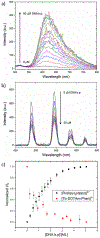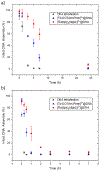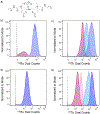Metallointercalators-DNA Tetrahedron Supramolecular Self-Assemblies with Increased Serum Stability
- PMID: 35133785
- PMCID: PMC8926058
- DOI: 10.1021/acsnano.1c10084
Metallointercalators-DNA Tetrahedron Supramolecular Self-Assemblies with Increased Serum Stability
Abstract
Self-assembly of metallointercalators into DNA nanocages is a rapid and facile approach to synthesize discrete bioinorganic host/guest structures with a high load of metal complexes. Turberfield's DNA tetrahedron can accommodate one intercalator for every two base pairs, which corresponds to 48 metallointercalators per DNA tetrahedron. The affinity of the metallointercalator for the DNA tetrahedron is a function of both the structure of the intercalating ligand and the overall charge of the complex, with a trend in affinity [Ru(bpy)2(dppz)]2+ > [Tb-DOTAm-Phen]3+ ≫ Tb-DOTA-Phen. Intercalation of the metal complex stabilizes the DNA tetrahedron, resulting in an increase of its melting temperature and, importantly, a significant increase in its stability in the presence of serum. [Ru(bpy)2(dppz)]2+, which has a greater affinity for DNA than [Tb-DOTAm-Phen]3+, increases the melting point and decreases degradation in serum to a greater extent than the TbIII complex. In the presence of Lipofectamine, the metallointercalator@DNA nanocage assemblies substantially increase the cell uptake of their respective metal complex. Altogether, the facile incorporation of a large number of metal complexes per assembly, the higher stability in serum, and the increased cell penetration of metallointercalator@DNA make these self-assemblies well-suited as metallodrugs.
Keywords: DNA tetrahedron; cell uptake; metallointercalator; serum stability; supramolecular self-assembly.
Conflict of interest statement
The authors declare no competing financial interest.
Figures









Similar articles
-
A theoretical study of Ru(II) polypyridyl DNA intercalators structure and electronic absorption spectroscopy of [Ru(phen)2(dppz)]2+ and [Ru(tap)2(dppz)]2+ complexes intercalated in guanine-cytosine base pairs.J Inorg Biochem. 2010 Sep;104(9):893-901. doi: 10.1016/j.jinorgbio.2010.04.002. Epub 2010 Apr 14. J Inorg Biochem. 2010. PMID: 20554006
-
DNA cross-linking with metallointercalator-peptide conjugates.Biochemistry. 2002 Oct 22;41(42):12785-97. doi: 10.1021/bi020407b. Biochemistry. 2002. PMID: 12379121
-
Crystal structures of Λ-[Ru(phen)₂dppz]²⁺ with oligonucleotides containing TA/TA and AT/AT steps show two intercalation modes.Nat Chem. 2012 Jun 24;4(8):621-8. doi: 10.1038/nchem.1397. Nat Chem. 2012. PMID: 22824893
-
Ruthenium(ii) complexes with dppz: from molecular photoswitch to biological applications.Dalton Trans. 2016 Sep 14;45(34):13261-76. doi: 10.1039/c6dt01624c. Epub 2016 Jul 18. Dalton Trans. 2016. PMID: 27426487 Review.
-
Critical Overview of the Use of Ru(II) Polypyridyl Complexes as Photosensitizers in One-Photon and Two-Photon Photodynamic Therapy.Acc Chem Res. 2017 Nov 21;50(11):2727-2736. doi: 10.1021/acs.accounts.7b00180. Epub 2017 Oct 23. Acc Chem Res. 2017. PMID: 29058879 Review.
Cited by
-
Luminescent Lanthanide Probes for Inorganic and Organic Phosphates.Chem Asian J. 2022 Aug 15;17(16):e202200495. doi: 10.1002/asia.202200495. Epub 2022 Jul 5. Chem Asian J. 2022. PMID: 35750633 Free PMC article. Review.
-
Nano-Bio Interactions between DNA Nanocages and Human Serum Albumin.J Chem Theory Comput. 2023 Nov 14;19(21):7873-7881. doi: 10.1021/acs.jctc.3c00720. Epub 2023 Oct 25. J Chem Theory Comput. 2023. PMID: 37877553 Free PMC article.
-
Advancing the Utility of DNA Origami Technique through Enhanced Stability of DNA-Origami-Based Assemblies.Bioconjug Chem. 2023 Jan 18;34(1):6-17. doi: 10.1021/acs.bioconjchem.2c00311. Epub 2022 Aug 19. Bioconjug Chem. 2023. PMID: 35984467 Free PMC article. Review.
References
-
- Simoncelli S; Li Y; Cortés E; Maier SA Nanoscale Control of Molecular Self-Assembly Induced by Plasmonic Hot-Electron Dynamics. ACS Nano. 2018, 12, 2184–2192. - PubMed
-
- Whitesides GM; Mathias JP; Seto CT Molecular Self-Assembly and Nanochemistry: A Chemical Strategy for the Synthesis of Nanostructures. Science. 1991, 254, 1312–1319. - PubMed
-
- Zhang S Fabrication of Novel Biomaterials Through Molecular Self-Assembly. Nat. Biotechnol 2003, 21, 1171–1178. - PubMed
-
- Tabacchi G Supramolecular Organization in Confined Nanospaces. ChemPhysChem. 2018, 19, 1249–1297. - PubMed
Publication types
MeSH terms
Substances
Grants and funding
LinkOut - more resources
Full Text Sources

